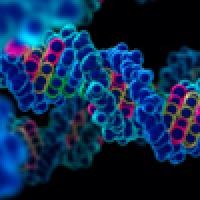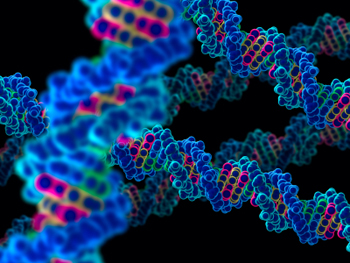Unravelling genomes
Solving the genome puzzleThe human genome is represented by a sequence of 3 billion As, Cs, Gs, and Ts. With such large numbers, sequencing the entire genome of a complex organism isn't just a challenge in biochemistry. It's a logistical nightmare which can only be solved with clever algorithms. Read more..
Career interview: Scientific data analyst, life science technology
Genomics is one of the fastest moving areas of science and Gavin Harper, a mathematician and statistician, has put himself right at its centre. He works for Oxford Nanopore Technologies, a company which is developing new technology for analysing molecules and sequencing DNA. With 75 employees from 18 different countries and all sorts of scientific backgrounds, Gavin's work environment is nothing like the solitary paper-and-pencil affair traditionally associated with mathematics.
Read more...
You're more than the sum of your genes
Geneticists are usually concerned with picking apart the individual genes that make up a genome, but recently biochemical engineers have decided to re-assemble all the pieces and give them a good shake. This news story from February 2009 explains that it's not just the genes themselves, but also the way in which they are organised within the genome, that determine the characteristics of an organism.
Read more...
Clever coiling
Something about nature loves a helix, the ubiquitous spiral shape taken on by DNA and many other molecules found in the cells of living creatures. This news story from March 2005 explains how physicists may have a mathematical answer to why this shape is so common in nature.
Read more...
Why knot: knots, molecules and stick numbers
We have depended on knots for thousands of years to hold things together. In the 1800's the mathematical theory of knots was born out of attempts to model the atom. This article from 2001 explores knot theory, and the role it plays in knotting and unknotting DNA molecules. Read more...
| Fighting disease
Modelling cell suicide This article sheds light on suicidal cells and a mathematical model that could help fight cancer. Read more...
Influenza virus: it's all in the packaging! We have all become more aware of the dangers of influenza this year, but why is it so dangerous? Julia Gog explains that the unusual structure of the influenza genome can lead to dangerous evolutionary jumps, and how mathematics is helping to understand how the virus replicates. Read more...
Understanding the noiseAll chemical reactions are probabilistic, including those acting on the information stored in the DNA inside our cells. This news story from February 2004 reports on a mathematical model that simplifies the problem of noise in monitoring molecular reactions like those involved in the expression of genes. Read more...
|
|
DNA evidence in court
It's a match"It's a match!" cries the CSI. At first glance it might seem that if the police have matched a suspect's DNA to evidence from the crime scene, then the case is closed. But some statistical thinking is required to understand exactly what a match is, and importantly, how juries should assess this as part of the evidence in a trial. Read more...
Seeking truth with statisticsAs if deciding on guilt or innocence wasn't a big enough burden for juries, many now also have to struggle with complex scientific evidence. It is vital that the statistical arguments involved are presented in a meaningful way. This article, a news story from June 2004, reports on a meeting of the Royal Statistical Society's General Applications Section that was tackling this difficult task.Read more...
| |
| Understanding our ancestry
Of pancakes, mice and menGenes normally evolve by tiny mutations, but every now and then something more radical occurs and entire genes along a chromosome get flipped. Understanding gene flipping boils down to solving a problem from pure maths. This articles explains, taking us on a journey from waiters sorting pancakes, via one of the richest men in the world, to the genetic similarities of mice and humans. Read more...
Reconstructing the tree of lifeLast year saw the 150th anniversary of the publication of On the origin of species, and the 200th anniversary of the birth of its author, Charles Darwin. At the heart of Darwin's theory of evolution lies a beautifully simple mathematical object: the evolutionary tree. In this article we look at how maths is used to reconstruct and understand it. Read more...
Natural selection, maths and milkAccording to Darwin, natural selection is the driving force of evolution. It's a beautifully simple idea, but given the thousands of years that are involved, nobody has ever seen it in action. So how can we tell whether or not natural selection occurs and which of our traits are a result of it? In this article Charlotte Mulcare uses milk to show how maths and stats can provide genetic answers. Read more...
|
|

